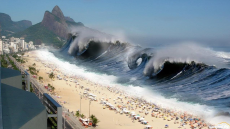

The Indonesian Earthquake/Tsunami
When - 26th December 2004 at 7:58 am
Where - Under the sea just off the coast of the Indonesian island Sumatra
Earthquake strength - 9.1 on the Richter scale
Causes
The earthquake occurred on a destructive plate boundary between the Indo-Australian plate and the Eurasian plate.
The Indo-Australian plate slid under the Eurasian plate causing a large build-up of pressure.
The pressure was released at 8 am Indonesian time. It was released as the Indo-Australian plate went further down towards the mantle under the Eurasian plate. This caused the Eurasian plate to rise by 15m.
The epicentre of the earthquake was only 20km under the sea which is quite shallow for an epicentre. This increased the earthquake’s damage.
Immediate Effects
The earthquake caused the land to shake violently for 10 minutes causing damage to buildings in Sumatra, particularly in Banda Aceh, Sumatra’s capital.
13 countries were affected by the earthquake.
The earthquake triggered four major tsunamis up to 30m high that spread as much as 2km inland.
Over 250,000 people were killed over a third of whom were children. Of the dead approximately 166,000 were from Indonesia, 38,000 from Sri Lanka, 16,000 from India, 5300 from Thailand, and 5000 tourists.
The worst ever train disasters was caused by a tsunami in Sri Lanka. The train, which was travelling along Sri Lanka’s coast, was washed away killing 1700 people.
It is estimated that the energy that was released in shockwaves was as much as the USA uses in 11 days.
The earthquake caused the entire Earth’s surface to move vertically by 1cm
Over 500,000 people were injured
The tsunami travelled 3000 miles to Africa and arrived with enough force to kill people and destroy property.
Most coastal settlements in Indonesia and many in Thailand, Bangladesh, India and Sri Lanka were totally destroyed because many were made of wood and so were easily swept away.
Long Term Effects
The water pouring inland caused much of the coastline around the Indian Ocean to change shape.
Over 1.7 million people were left homeless.
After the tsunami water-borne diseases such as cholera and typhoid spread quickly due to lack of fresh drinking water and sanitation.
Many coastal marine areas became polluted as the retreating tsunamis dragged debris and bodies out to sea. Also the tsunamis destroyed lots of coral.
The events reduced tourist numbers and the money and jobs tourism brings.
5-6 million people needed emergency food, water and medical supplies.
Fishermen lost their livelihoods.
The infrastructure in many countries was severely damaged.
Human Response
Hundreds of millions of pounds was pledged by foreign countries, charities, individuals and businesses to give people emergency supplies.
Countries sent ships, planes, soldiers and specialists to rescue people, distribute food, water and start clearing up.
Billions of pounds were pledged to rebuild infrastructure.
Programmes were set up to rebuild houses and to help people get back to work.
Seismometers were placed on the sea floor plate boundaries, so that when there are foreshocks they are sensed and a warning signal is relayed to warning centres in all Indian Ocean countries.
Hotels are now required to put car parks on the ground floor and accommodation on the first floor and above. This would mean the wave would pass through the ground floor and only destroy cars.
All the Indian Ocean countries are developing tsunami evacuation procedures, which are rehearsed regularly so that with even only a few minutes people can get to safety.
The procedures encourage tourists to seek high ground.
image-https://www.youtube.com/watch?v=Z-2khcTHIgs

0 Comment:
Be the first one to comment on this article.